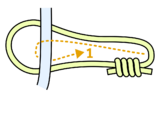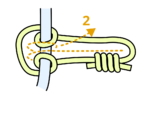Prusik knot
| Prusik knot | |
|---|---|
 | |
| Other names | Prusik, Prusik hitch |
| Use(s) | abseiling, advanced rope techniques including (self-)rescue techniques |
| Pros | Fast, clean, just an accessory cord or a sling needed |
| Cons | Compared to traxion, tiblocs and such it is a bit tedious to get loosen in some cases and it must be moved actively |
| Category | Hitch |
| Strength | ~5-8 kN when a 5-7mm accessory cord is used[1] |
Review state This page has not been reviewed yet (review state explanation). |
Prusik knot (technically a hitch) is a very versatile hitch used among other applications in abseiling, pulley systems, and Prusiking up the ropes. In some of the applications it can be replaced by tibloc and various traxions and similar devices which provides improved comfort of use by unidirectionally moving seamlessly on the rope, while providing the same stopping functionality as Prusik.
Tying
Number of loops varies based on desired amount of friction.
Diameter recommendations
Based on the cord load limits, 5 mm (5.1 kN) and 6 mm (10 kN) reep cords are generally recommended for tying Prusiks.[2] General rule of a thumb is that to ensure a reliable blocking, Prusik cord diameter should be roughly 1/2 of a diameter of the rope on which the Prusik is tied. For a standard climbing rope (~9.7 mm), the slightly-above-recommendation 6 mm cord has the advantage that it is easier to loosen. Another advantage is that its loading limit is twice the one of the 5 mm cord. However, in some rope-Prusik combinations, Prusik from 6 mm cord might not block readily enough. But in some cases, 5 mm Prusik is nearly impossible to loosen under and after load. Testing in safe environment is therefore highly recommended both for the 5 mm and the 6 mm cord.
References
- ↑ Jenks, Ryan (16 June 2021). Prusik, Auto Blocks, and Klemheist Break Tests. HowNOT2. Retrieved 16 August 2025.
- ↑ LANEX a.s. "Acessory cords". tendon.cz. LANEX a.s. Retrieved 16 August 2025.




